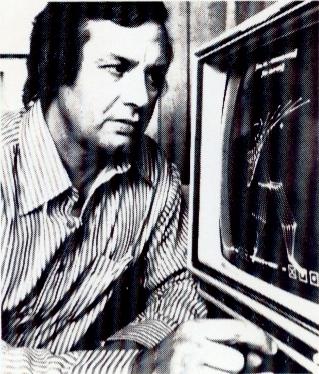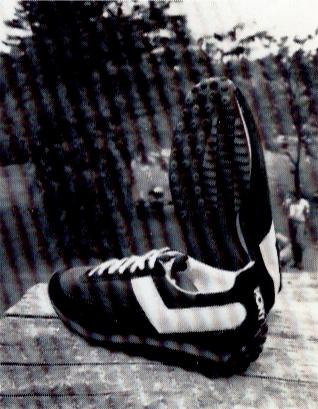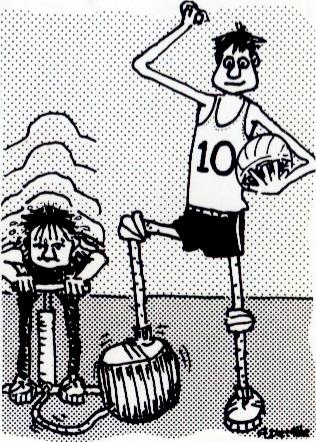| Previous | Index |
![]()
4 The Development: With this information, Pony's design and production engineers knew the structural requirements and materials critical to the creation of a running shoe which would most sufficiently provide the two qualities Ariel determined were absolutely necessary in an athletic shoe; shark uhsurpliun and return uheneri,v. Ariel explains: "You see pictures of runners, it looks like they're landing on their heels, but they are not. The good ones don't. They flick the foot down flat at the last instant. Too many companies were making wonderful heels and the best runners weren't coming down on them." What Aricl knew from his studies was the slight, but powerful, rotation of the foot which occurred (luring each contact with the ground in an athlete's stride. Different areas of the sole were performing different functions, yet nearly all athletic footwear, including Pony's original Runner, had uniform soles with some type of grid pattern or nipple affect. Pony designers, working with Ariel, slowly developed a sole with two distinct features, each conceived to provide the shock absorption and the return of energy deemed invaluable for high performance. They changed the shoe's construction by using two sole materials, realigned the nipple pattern on most of the contact surface and added it "traction grid'' on the inside of the sole, where motion study showed the runner used his power during each stride.
5 The finished product: With the addition 01'a lightweight, durable upper and the familiar Pony chevron symbol, the company has what they feel is the most sophisticated racing shoe on the market. The heart of these shoes, though, is that Ariel-conceived sole. There are two versions of the shoe, the training model (shown) and the racing model. The trainer is slightly heavier and more durable than the racer. because it will he needed for those long, gruelling practice sessions. I'he racer is expected to he used for exactly that - racing. The VSI) sole (patent pending) is, by the way, endorsed by Jim Bush, the head track and field coach of the l:niversity of ('alifornia al Los Angeles (ll('LA). All of this research, presumably, cost money, but I'hom Uravelle, executive vice-president of Puny, is adamant that athletic footwear prices will not skyrocket because uI' it. I to said at the beginning of the year: "Our strategy is to market the finest athletic footwear al prices that will give the retailer a decent profit margin for a change, and vet give the consumer quality products at prices which are not Outrageous... The Racer, he thinks, will fill that hope and then sonic. Reaction to the shoe has been favorable, hit it will have to prove itself in the future.
U 6 I'hc future: While Pony and other companies struggle to keep their product at reasonable prices, the research and development continues. But where will it lead? What I'ulure refinements will athletic footwear undergo as producers scramble to conic out with the most "modern" shoe' Well, the quest for the perfect sneaker may one clay he over. Ariel, in his continuing work l'or Pony, is developing - are you ready'? - an inflatable running shoe. Someday, an athlete will simply slip the limp casing of' the shoe over each foot, fill it up with air and, presto, a perfect fit. l le may not even have shoelaces to tic. More important, Pony points out, the shoe will he good for his feet, absorbing shock better and reducing the likelihood of shin splints and blisters. The research for this shoe has been going on for more than a year now, and company officials expect another yearand-a-hall' before they will he ready to take orders for the shoe. The inflatable shoe will he lighter than the conventional model and may only cone in four sizes - small, medium, large and extra large - because the shoe will mold itself to the foot. Ariel envisions the shoe as having a valve that will accept the nozzle of a can of compressed air, and can he released to deflate (he shoe. Laces will he replaced by an elastic hand. 11' the shoe works, and sells, what will be the next step in footwear development'? Ariel just might have some secret ideas on (hill subject - but he's not telling.
CANADIAN FOOTWEAR JOURNAL August 1978



![]()
| Previous | Index |